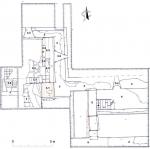Summary (English)
DEULTUM (Lyudmil Vagalinski – lvagalin@techno-link.com) The excavations of the Late Roman northwestern corner fortification tower continued. Parts of the pavement of a cardo and its eastern kerb were discovered. A water-conduit of terracotta pipes was documented beneath the street pavement. A building with a bath was discovered, situated to the east of the kerb. Probably, it was a domus that reached the temple of the imperial cult to the east. The building was burned down after AD 270, probably during a Gothic attack. After the fire, the northwestern corner fortification tower was built over the cardo. The tower had a barrel-vaulted entrance and a stone staircase leading towards its upper floors. It was part of the Late Roman fortification wall with the monumental trapezoid tower in the middle. Thus, the fortification that was built at the end of the 3rd century AD, or a little bit later, narrowed the fortified area of Deultum from the west. A fire that occurred after AD 401/403 destroyed the tower. It was reconstructed, but soon another attack occurred after AD 410/430. Later on, soon after AD 491/518 the tower was burned during another attack. A gold tremissis of Anastasius I Dicorus was found in the debris. Subsequently, dolia were stored in the tower. Soon after AD 565/578, the fortification of Deultum was destroyed by an attack of Avars and Slavs. A follis of Leo IV the Khazar and Constantine VI, minted in AD 776/778, indicated some human activity in the area of the tower in that time. The archaeobotanical samples showed the presence of supplies of compact common wheat and ground rye. Large guard dogs died in the tower during the last attack and meat from butchered pigs, cattle and sheep/goats was stored there. The finds from the excavations included coins, weapons, pottery, glass vessels, terracotta lamps, iron tools and jewelry.
- Lyudmil Vagalinski - Archaeological Institute with Museum
Director
- Lyudmil Vagalinski - Archaeological Institute with Museum
Team
Research Body
- Archaeological Institute with Museum






![Download [PDF]](/excavation/skins/fasti/images/results/download_sml.png)
